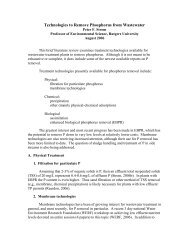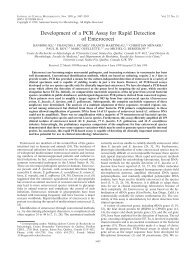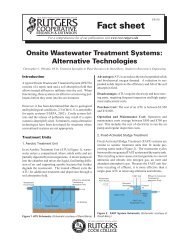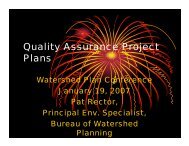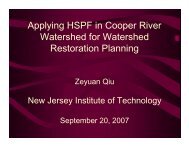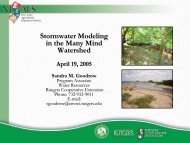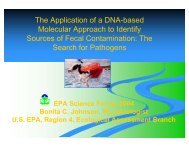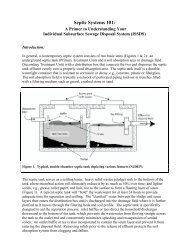Microbial source tracking with optical brighteners
Microbial source tracking with optical brighteners
Microbial source tracking with optical brighteners
You also want an ePaper? Increase the reach of your titles
YUMPU automatically turns print PDFs into web optimized ePapers that Google loves.
LITERATURE REVIEW ON MICROBIAL SOURCE TRACKINGWITH OPTICAL BRIGHTENERSMarch 29, 2010Steven YergeauLiterature ReviewThe United States Environmental Protection Agency (USEPA) has reported there areover 44,000 impaired waters and over 75,000 associated water quality impairments in thecountry (USEPA 2008). Of these impairments, 10,662 are caused by pathogens (primarilybacteria). The Clean Water Act mandates that state agencies must develop a total maximumdaily load (TMDL) and a watershed management plan for impaired water bodies to improvewater quality (USEPA 1997). A TMDL is a calculation of the maximum pollution a water bodycan receive from the sum of point and non-point <strong>source</strong>s in the watershed and remain incompliance <strong>with</strong> water quality standards (USEPA 1991). For New Jersey, 270 TMDLs havebeen approved by the USEPA for fecal coliform pollution. Once a TMDL is established, awatershed protection plan must be developed and adopted to reduce contaminant <strong>source</strong>s in orderto attain TMDL goals (USEPA 2008). This plan must include <strong>source</strong> identification anddevelopment of strategies for mitigation of these <strong>source</strong>s.Source identification of pollutants in a watershed is accomplished via field sampling atseveral locations under various hydrological conditions <strong>with</strong>in the area of concern, numericalsimulations, or a combination of these. Field measurements can be used directly to identify<strong>source</strong>s, or to calibrate numerical simulations used to identify those <strong>source</strong>s. Fieldmeasurements, however, are often costly and cannot achieve spatial or temporal resolutions1
necessary to accurately represent all watershed processes, nor may they be used to assess impactsdue to mitigation activities.Most often when determining pathogen contamination, indicator organisms are monitored(Simpson et al. 2002; Scott et al. 2002; Stoeckel and Harwood 2007). Fecal coliform or E. coliare typically sampled to indicate the presence or absence of contamination from fecal matter.Using an indicator organism to solve fecal contamination problems in surface waters presentsseveral challenges. First, fecal coliform is solely an indicator of fecal pollution and not a directmeasure of fecal contamination. Other methods may be appropriate for determining actualconcentrations of bacteria in surface waters. Second, fecal coliform does not identify <strong>source</strong>s offecal pollution, only its presence. Therefore, it is imperative that prior to any remediationstrategy, potential <strong>source</strong>s of pollution be identified. This will target efforts to efficiently usere<strong>source</strong>s (time, effort, money) so that maximum benefits to water quality can be achieved andcontamination effectively reduced.There are a variety of <strong>source</strong>s from which fecal contamination can originate. Potential<strong>source</strong>s of fecal coliform contamination include failing sanitary sewer or septic systems, wildlifeand waterfowl. Agricultural practices including the spreading of manure and its use as afertilizer could potentially lead to runoff of fecal-related pathogens. Livestock access towaterways can also lead to direct introductions to streams. Improper disposal of domestic petwastes is also a potential <strong>source</strong> of pathogen pollution. Recently, dumpsters have beenrecognized as a <strong>source</strong> of pathogens in stormwater runoff due to birds using dumpsters asfeeding locations; this is also true of rodents (Central Coast Water Board 2006).<strong>Microbial</strong> <strong>source</strong> <strong>tracking</strong> (MST) is a series of methods employed to determine <strong>source</strong>s ofmicrobial pollution, whether from bacteria or other pathogens such as viruses and protozoans2
ighteners <strong>with</strong>in streams is unknown. A study in Rhode Island found that interference ofhumic acids in the stream limited the value of this method of <strong>source</strong> <strong>tracking</strong> to the local vicinityof the <strong>source</strong> (Boving et al. 2004). In California, decay of <strong>optical</strong> <strong>brighteners</strong> due to sunlight wasevaluated for a variety of detergents (Cao et al. 2009). It was found that, depending on detergentmanufacturer, after 30 minutes of exposure to UV light fluorescence was reduced by 13.2% to71.7% (Cao et al. 2009). In addition, discharges that contain <strong>optical</strong> <strong>brighteners</strong> are noncontinuous.Sporadic grab sampling may miss discharges from human <strong>source</strong>s and continuousmonitoring may be necessary to accurately determine levels of <strong>optical</strong> <strong>brighteners</strong> present.In order to overcome some of these concerns and gain a better understanding of the<strong>source</strong>s of contaminants of human origin, tiered approaches can be applied to <strong>source</strong> <strong>tracking</strong>studies. Tiered approaches study multiple levels, multiple scales, or measuring multipleparameters <strong>with</strong> increasing focus as one moves through each tier. This has been recommendedby investigators as a successful means of <strong>tracking</strong> fecal contamination <strong>source</strong>s (Boehm et al.2003; Stewart et al. 2003; Noble et al. 2006; Cao et al. 2009). The tiered approach can aidwatershed management in abating the most significant <strong>source</strong>s of fecal bacteria (or otherpollutant of concern) (Noble et al. 2006). Objectives and tasks are developed in this approach sothat appropriate management practices are implemented and re<strong>source</strong>s are allocated efficientlyand economically throughout a watershed.A short literature search has not found studies where a tiered approach was conductedusing <strong>optical</strong> <strong>brighteners</strong> as one of the tiers. This represents a gap in the ability to track <strong>source</strong>sof fecal contamination. To help fill this need, a proposed scheme for determining human <strong>source</strong>susing <strong>optical</strong> <strong>brighteners</strong> as part of the Musquapsink Brook Watershed restoration plan isoutlined below:5
TITLE: Source Determination of Human-Related Fecal Contamination: A Tiered Approach forWatershed ManagementTier 1: Screening for fecal coliform contamination• Surface water quality sampling performed during both wet and dry weather to determine thepresence of fecal contamination.Tier 2: Location of human and non-human fecal “hot spots”• MST sampling using qPCR analysis to differentiate between human and non-human <strong>source</strong>sof bacterial loadings to surface waters.Tier 3: Source <strong>tracking</strong> <strong>with</strong> <strong>optical</strong> <strong>brighteners</strong>• Use fluorometric analysis to detect the presence of <strong>optical</strong> <strong>brighteners</strong> in the stream andpossibly correlate <strong>with</strong> dissolved oxygen measurements in order to verify sewer/septicdischarges.Optical <strong>brighteners</strong> show promise as a method of MST in watershed restoration planning butadditional field sampling and comparisons <strong>with</strong> other methods need to be conducted to determinetheir effectiveness in watershed management.6
REFERENCESBoehm, A.B., J.A. Fuhrman, R.D. Mrse, and S.B. Grant. 2003. Tiered Approach forIdentification of a Human Fecal Pollution Source at a Recreational Beach: Case Study atAvalon Bay, Catalina Island, California. Environmental Science and Technology.37:673-680.Boving, T.B., D.L. Meritt, and J.C. Boothroyd. 2004. Fingerprinting Sources of Bacteria Inputinto Small Residential Watersheds: Fate of Fluorescent Whitening Agents.Environmental Geology. 46:228-232.Cao, Y., J.F. Griffith, and S.B. Weisberg. 2009. Evaluation of Optical Brightener PhotodecayCharacteristics for Detection of Human Fecal Contamination. Water Research. 43:2273-2279.Central Coast Water Board. 2006. Total Maximum Daily Loads for Pathogens in Aptos andValencia Creeks, including Trout Gulch, Santa Cruz, California. San Luis Obispo, CA.Dick, L.K., A.E. Bernhard, T.J. Brodeur, J.W. Santo-Domingo, J.M. Simpson, S.P. Walters andK.G. Field. 2005. Host Distributions of Uncultivated Fecal Bacteroidales BacteriaReveal Genetic Markers for Fecal Source Identification. Applied and EnvironmentalMicrobiology. 71(6):3184-3191.Hagedorn, C. and S.B. Weisberg. 2009. Chemical-Based Fecal Source Tracking Methods:Current Status and Guidelines for Evaluation. Reviews in Environmental Science andBiotechnology. 8:275-287.Hartel, P.G., J. McDonald, L. Gentit, S. Hemmings, K. Rodgers, K. Smith, C. Belcher, R. Kuntz,Y. Rivera-Torres, E. Otero, and E. Schroder. 2007. Improving Fluorometry as a Source7
Tracking Method to Detect Human Fecal Contamination. Estuaries and Coasts. 30:551-61.Hartel, P.G., K. Rodgers, G.L. Moody, S.N.J. Hemmings, J.A. Fisher, and J.L. McDonald. 2008.Combining a Targeted Sampling and Fluorometry to Identify Human FecalContamination in a Freshwater Creek. Journal of Water and Health. 6(1):105-116.Layton, A., L. McKay, D. Williams, V. Garrett, R. Gentry and G. Sayler. 2006. Development ofBacteroides 16S rRNA Gene TaqMan-Based Real-Time PCR Assays for Estimation ofTotal, Human, and Bovine Fecal Pollution in Water. Applied and EnvironmentalMicrobiology. 72(6):4214-4224.McDonald, J.L., P.G. Hartel, L.C. Gentit, C.N. Belcher, K.W. Gates, K. Rodgers, J.A. Fisher,K.A. Smith, and K.A. Payne. 2006. Identifying Sources of Fecal ContaminationInexpensively <strong>with</strong> Targeted Sampling and Bacterial Source Tracking. Journal ofEnvironmental Quality. 35:889-897.Noble, R.T., J.F. Griffith, A.D. Blackwood, J.A. Fuhrman, J.B. Gregory, X. Hernandez, X.Liang, A.A. Berg, and K. Schiff. 2006. Multitiered Approach Using Quantitative PCRto Track Sources of Fecal Pollution Affecting Santa Monica Bay, California. Appliedand Environmental Microbiology. 72(2):1604-1612.Scott, T.M., J.B. Rose, T.M. Jenkins, S.R. Farrah, and J. Lukasik. 2002. <strong>Microbial</strong> SourceTracking: Current Methodology and Future Directions. Applied and EnvironmentalMicrobiology. 68(12):5796-5803.Simpson, J.M., J.W. Santo Domingo, and D.J. Reasoner. 2002. <strong>Microbial</strong> Source Tracking:State of the Science. Environmental Science and Technology. 36(24): 5279-5288.8
Stewart, J.R., R.D. Ellender, J.A. Gooch, S. Jiang, S.P. Myoda, and S.B. Weisberg. 2003.Recommendations for <strong>Microbial</strong> Source Tracking: Lessons from a Methods StudyComparison. Journal of Water and Health. 1(4):225-231.Stoeckel, D.M. and V.J. Harwood. 2007. Performance, Design, and Analysis in <strong>Microbial</strong>Source Tracking Studies. Applied and Environmental Microbiology. 73(8):2405-2415.Tavares, M.E., I.H. Spivey, M. McIver, and M.A. Mallin. 2008. Testing for Optical Brightenersand Fecal Bacteria to Detect Sewage Leaks in Tidal Creeks. University of NorthCarolina Wilmington Center for Marine Sciences.http://people.uncw.edu/hillj/classes/EVS595/Optical%20brightener%20paper%20for%20NCAS.pdfUnited States Environmental Protection Agency (USEPA). 1991. Guidance for Water QualityBased Decisions in the TMDL Process. EPA 440/4-91-001. Washington, D.C.: U.S.EPA, Office of Water. Available at: www.epa.gov/OWOW/tmdl/decisions.United States Environmental Protection Agency (USEPA). 1997. National Water QualityInventory: 1996 Report to the United States Congress. EPA 841-R-97-005. Washington,D.C.: U.S. EPA.United States Environmental Protection Agency (USEPA). 2005. <strong>Microbial</strong> Source TrackingGuidance Document. EPA/600/R-05/064. Office of Research and DevelopmentNational Risk Management Research Library. Washington, DC. 151 pp.United States Environmental Protection Agency (USEPA). 2008. Water Quality Assessmentand Total Maximum Daily Loads Information (ATTAINS). Retrieved February 2010from http://www.epa.gov/waters/ir/.9


